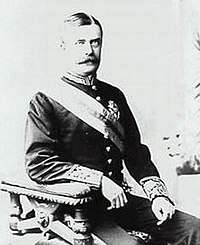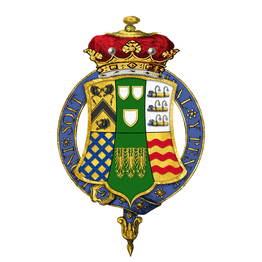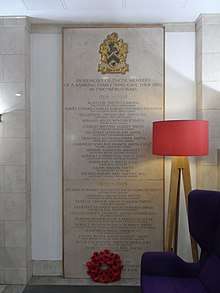Charles Wynn-Carington, 1st Marquess of Lincolnshire
Charles Robert Wynn-Carington, 1st Marquess of Lincolnshire, KG, GCMG, PC, JP, DL (16 May 1843 – 13 June 1928), known as the Lord Carrington from 1868 to 1895, and as the Earl Carrington from 1895 to 1912, was a British Liberal politician and aristocrat. He was Governor of New South Wales from 1885 to 1890.
The Marquess of Lincolnshire KG GCMG PC JP DL | |
|---|---|
 | |
| Lord Privy Seal | |
| In office 23 October 1911 – 13 February 1912 | |
| Prime Minister | H. H. Asquith |
| Preceded by | The Marquess of Crewe |
| Succeeded by | The Marquess of Crewe |
| President of the Board of Agriculture | |
| In office 10 December 1905 – 23 October 1911 | |
| Prime Minister | Sir Henry Campbell-Bannerman H. H. Asquith |
| Preceded by | Ailwyn Fellowes |
| Succeeded by | Walter Runciman |
| Lord Chamberlain | |
| In office 15 August 1892 – 22 June 1895 | |
| Prime Minister | William Ewart Gladstone Lord Rosebery |
| Preceded by | The Earl of Lathom |
| Succeeded by | The Earl of Lathom |
| Governor of New South Wales | |
| In office 12 December 1885 – 3 November 1890 | |
| Monarch | Victoria |
| Preceded by | Lord Augustus Loftus |
| Succeeded by | The Earl of Jersey |
| Captain of the Honourable Corps of Gentlemen-at-Arms | |
| In office 27 June 1881 – 6 July 1885 | |
| Prime Minister | William Ewart Gladstone |
| Preceded by | The Marquess of Huntly |
| Succeeded by | The Earl of Coventry |
| Member of Parliament for Wycombe | |
| In office 24 July 1865 – 17 March 1868 | |
| Preceded by | Martin Tucker Smith |
| Succeeded by | William Carington |
| Member of the House of Lords Lord Temporal | |
| In office 17 March 1868 – 13 June 1928 Hereditary peerage | |
| Preceded by | The 2nd Baron Carrington |
| Succeeded by | The 4th Baron Carrington |
| Personal details | |
| Born | Charles Robert Carrington 16 May 1843 Whitehall, London |
| Died | 13 June 1928 (aged 85) Daws Hill House, High Wycombe, Buckinghamshire |
| Nationality | British |
| Political party | Liberal |
| Spouse(s) | Hon. Cecilia Margaret Harbord (m. 1878–1928; his death) |
| Children | 6 |
| Parents | Robert Carrington, 2nd Baron Carrington Charlotte Drummond-Burrell |
| Alma mater | Trinity College, Cambridge |
Background
Charles Robert Carrington was born at Whitehall on 16 May 1843, the son of Robert Carrington, 2nd Baron Carrington, and his second wife Charlotte, the younger daughter of Peter Drummond-Burrell, 22nd Baron Willoughby de Eresby.[1] The Hon. Sir William Carington and Rupert Carington, 4th Baron Carrington, were his younger brothers, while Peter Carington, 6th Baron Carrington, was his grand-nephew. He was educated at Eton and Trinity College, Cambridge.[2] He was a lifelong friend of King Edward VII, having first met him in 1854.
On his mother's death in 1879 he became joint hereditary Lord Great Chamberlain of England. Born Charles Carrington, he and his two brothers assumed by Royal Licence the surname of Carington in 1880. In 1896 he assumed by Royal Licence the surname of Wynn-Carington.
Political career

Carrington sat in the House of Commons as a Liberal for High Wycombe from 1865 until he succeeded his father to the baronies in 1868. He served under William Ewart Gladstone as Captain of the Honourable Corps of Gentlemen-at-Arms from 1881 to 1885, and was sworn of the Privy Council in 1881.[3]
He was appointed to be the Governor of New South Wales in 1885[4] until 1890 and was appointed to the Order of St Michael and St George as a Knight Grand Cross in June 1885.[5] He again held office under Gladstone and later Lord Rosebery as Lord Chamberlain of the Household from 1892 to 1895. The latter year he was created Viscount Wendover, of Chepping Wycombe, in the County of Buckingham, and Earl Carrington.[6]
In early 1901 he was appointed by King Edward VII to lead a special diplomatic mission to announce the King's accession to the governments of France, Spain, and Portugal.[7]
After the Liberals returned to power in 1905 he served as President of the Board of Agriculture between 1905 and 1911 and as Lord Privy Seal between 1911 and 1912, with a seat in the cabinet in Sir Henry Campbell-Bannerman and H. H. Asquith's ministries. He was made a Knight of the Garter in 1906[8] and in 1912 he was further honoured when he was made Marquess of Lincolnshire.[9][10]
A noted land reformer, Carrington was a supporter of Lloyd George's redistributive "People's Budget", which he regarded as "bold, Liberal and humane".[11]
Freemasonry
He was initiated into Isaac Newton University Lodge No. 859, Cambridge, on 28 October 1861 at the age of 18, passed in Cairo some 8 years later, and raised in Royal York Lodge of Perseverance No. 7 on 6 October 1875. On 3 January 1882 he became a member of Royal Alpha Lodge No. 16. Even though he was not a past Master of a Lodge, he was appointed Senior Grand Warden of the United Grand Lodge of England in 1882.
When he became Governor of New South Wales, he found a rivalry of lodges working under the United Grand Lodge of England and the Grand Lodge of Scotland as well as lodges working under other constitutions. Trying to unite the lodges, he became firstly District Grand Master of New South Wales, and then the first Grand Master of the newly consecrated Grand Lodge of New South Wales. However, as he had still not yet been installed as a Worshipful Master, he was first made Worshipful Master at sight of the Lodge Ionic No. 15. Nine senior Masons were present, including Samuel Way. In 1890 he was appointed Provincial Grand Master of Buckinghamshire and after serving five years, he was made Grand Representative in England of the United Grand Lodge of New South Wales.[12]
Family

Carrington married the Hon. Cecilia Margaret Harbord (1856–1934), daughter of Charles Harbord, 5th Baron Suffield, and Cecilia Annetta Baring, in 1878. They had one son and five daughters. Their only son, Albert Edward Charles Robert Wynn-Carington, Viscount Wendover (1895–1915), died on 19 May 1915 of complications following the amputation of an arm when he was wounded in the fighting at Ypres during World War I.[13]
Having earlier sold his ancestral home, Wycombe Abbey (which became a private girls' boarding-school), Lincolnshire died at his home, Daws Hill House, High Wycombe, on 13 June 1928. The baronies (but not his other titles) passed to his younger brother, Rupert. The marquessate, earldom and viscountcy became extinct.[14] Cecilia, Marchioness of Lincolnshire, died in 1934, aged 78.
Issue
| Life span | Marriage(s) | Notes | |
|---|---|---|---|
| by Cecilia Margaret Harbord | |||
| Lady Marjorie Cecilia Wynn-Carington | 1880–1968 | Married Hon. Charles Wilson (later 2nd Baron Nunburnholme), son of Charles Wilson, 1st Baron Nunburnholme, and Florence Wellesley; had issue. | |
| Lady Alexandra Augusta Wynn-Carington | 1881–1955 | Married Col. William Palmer, son of Brig. George Palmer; had issue. | |
| Lady Ruperta Wynn-Carington | 1883–1963 | Married William Legge, Viscount Lewisham (later 7th Earl of Dartmouth), son of William Legge, 6th Earl of Dartmouth, and Lady Mary Coke; had issue. | |
| Lady Judith Sydney Myee Wynn-Carington | 1889–1928 | Married Walter Keppel, Viscount Bury (later 9th Earl of Albemarle), son of Arnold Keppel, 8th Earl of Albemarle, and Lady Gertrude Egerton; had issue. | |
| Lady Victoria Alexandrina Wynn-Carington | 1892–1966 | Married, firstly, Lt. Nigel Legge-Bourke, son of Sir Henry Legge and Amy Lambart; had issue. | Lt. Legge-Bourke, who was a first cousin of his brother-in-law Viscount Lewisham above, was killed in action in World War I. |
| Married, secondly, Major Hon. Edric Weld-Forester, son of Cecil Weld-Forester, 5th Baron Forester, and Emma Dixie; had issue. | |||
| Albert Edward Charles Robert Wynn-Carington, Viscount Wendover | 1895–1915 | Viscount Wendover died from wounds received in action in World War I.[13] | |
Other descendants
Among notable descendants are Stephen Wilson, 6th Baron Nunburnholme, Patrick Chichester, 8th Marquess of Donegall, and Rufus Keppel, 10th Earl of Albemarle.
Cousins Tiggy and Eleanor Legge-Bourke are his descendants through his fifth daughter; they are both granddaughters of politician Sir Harry Legge-Bourke, only son of Lt. Nigel Legge-Bourke.[15][16][17]
Ancestry
| Ancestors of Charles Wynn-Carington, 1st Marquess of Lincolnshire | |||||||||||||||||||||||||||||||||||||||||||||||||||||||||||||||||||||||||||||||||||||||||||||||||||||||||||||||||||||||||||||||||||||||||||||||||||||||||||||||||||||||||||||||||||||||||||||||||||||||||||||||||||||||||||||||||||||||||||||||||||||||||||||||||||||||||||||||||||||||||
|---|---|---|---|---|---|---|---|---|---|---|---|---|---|---|---|---|---|---|---|---|---|---|---|---|---|---|---|---|---|---|---|---|---|---|---|---|---|---|---|---|---|---|---|---|---|---|---|---|---|---|---|---|---|---|---|---|---|---|---|---|---|---|---|---|---|---|---|---|---|---|---|---|---|---|---|---|---|---|---|---|---|---|---|---|---|---|---|---|---|---|---|---|---|---|---|---|---|---|---|---|---|---|---|---|---|---|---|---|---|---|---|---|---|---|---|---|---|---|---|---|---|---|---|---|---|---|---|---|---|---|---|---|---|---|---|---|---|---|---|---|---|---|---|---|---|---|---|---|---|---|---|---|---|---|---|---|---|---|---|---|---|---|---|---|---|---|---|---|---|---|---|---|---|---|---|---|---|---|---|---|---|---|---|---|---|---|---|---|---|---|---|---|---|---|---|---|---|---|---|---|---|---|---|---|---|---|---|---|---|---|---|---|---|---|---|---|---|---|---|---|---|---|---|---|---|---|---|---|---|---|---|---|---|---|---|---|---|---|---|---|---|---|---|---|---|---|---|---|---|---|---|---|---|---|---|---|---|---|---|---|---|---|---|---|---|---|---|---|---|---|---|---|---|---|---|---|---|---|---|---|---|
| |||||||||||||||||||||||||||||||||||||||||||||||||||||||||||||||||||||||||||||||||||||||||||||||||||||||||||||||||||||||||||||||||||||||||||||||||||||||||||||||||||||||||||||||||||||||||||||||||||||||||||||||||||||||||||||||||||||||||||||||||||||||||||||||||||||||||||||||||||||||||
References
Citations
- Adonis 2010
- "Smith (or Wynn-Carrington), the Hon. Charles Robert Wynn (SMT861CR)". A Cambridge Alumni Database. University of Cambridge.
- "No. 24997". The London Gazette. 19 July 1881. p. 3543.
- "No. 25461". The London Gazette. 14 April 1885. p. 1669.
- "No. 25477". The London Gazette. 6 June 1885. p. 2631.
- "No. 26646". The London Gazette. 23 July 1895. p. 4158.
- "The King – the special Embassies". The Times (36410). London. 23 March 1901. p. 12.
- "Sir Charles Robert Wynn-Carington, 1st and last Marquess of Lincolnshire". The Peerage. Retrieved 13 October 2016.
- "No. 28586". The London Gazette. 1 March 1912. p. 1558.
- Martin, A. W. (1969). "Carrington, Charles Robert [Marquess of Lincolnshire] (1843–1928)". Australian Dictionary of Biography. Melbourne University Press. ISSN 1833-7538. Retrieved 3 April 2008 – via National Centre of Biography, Australian National University.
- Travis L. Crosby (30 January 2014). "The Unknown David Lloyd George: A Statesman in Conflict". Books.google.co.uk. p. 411. Retrieved 14 June 2016.
- "Lord Carrington". Retrieved 22 May 2018.
- "Viscount Wendover Dead". The Register. Adelaide, South Australia. 21 May 1915. p. 6. Retrieved 2 May 2012.
- Adonis, Andrew (May 2010). "Carington, Charles Robert Wynn-, marquess of Lincolnshire (1843–1928)". Oxford Dictionary of National Biography. Oxford University Press. Retrieved 13 June 2016.
- Tiggy Legge-Bourke, a Guardian Unlimited special report from The Guardian dated 13 October 1999. Retrieved 15 June 2016.
- LEGGE-BOURKE, Sir Edward Alexander Henry in Who Was Who 1971–1980 (London, A. & C. Black, 1989 reprint: ISBN 0-7136-3227-5).
- Mosley, C. (ed.), Burke's Peerage, Baronetage & Knightage, 107th edition (Burke's Peerage (Genealogical Books) Ltd, 2003), vol. 1, p. 1039.
Bibliography
- Adonis, Andrew (December 1988). "Aristocracy, Agriculture and Liberalism: the Politics, Finances and Estates of the third Lord Carrington". Historical Journal. 31 (4).
- Martin, A. W. (1969). "Carington, Charles Robert (1843–1928)". Australian Dictionary of Biography. National Centre of Biography, Australian National University. Retrieved 22 April 2016.
- Mayes, Leonard John (1960), The History of Chairmaking in High Wycombe, London: Routledge & K. Paul, OCLC 4378040
- Venn, J. A. (1953). Alumni Cantabrigienses, part 2, 5 (Cambridge: Cambridge University Press). p. 545
External links
| Wikimedia Commons has media related to Charles Wynn-Carington, 1st Marquess of Lincolnshire. |
| Wikisource has the text of the 1911 Encyclopædia Britannica article Carrington, Charles Robert Wynn-Carington. |
- Hansard 1803–2005: contributions in Parliament by Charles Wynn-Carington
